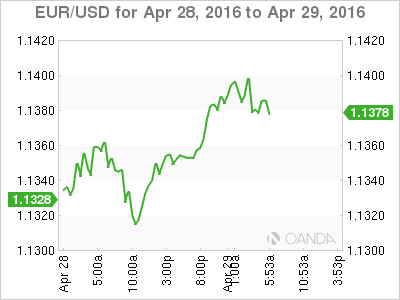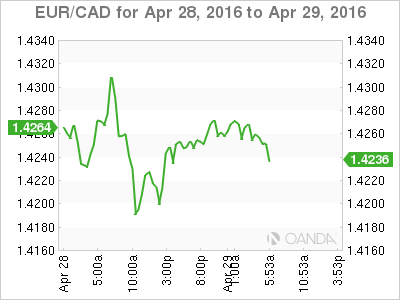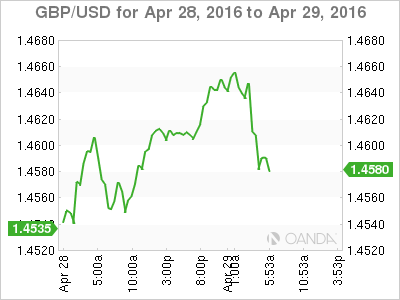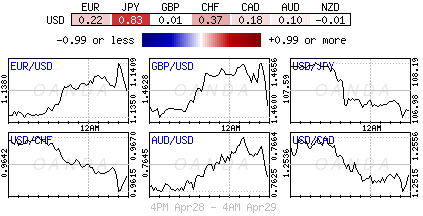It’s giddy times in Canada, with newly installed Prime Minister Justin Trudeau winning rave reviews at home and abroad, the nation’s economy generating some of the best positive surprises in the world and the domestic stock market soaring again.
And yet all foreign-exchange traders seem to want to know is what’s the latest price for crude oil. While Canada has made progress to lessen its dependence on the commodity, the local dollar’s correlation to oil has climbed, hovering near record-high levels touched in 2012, according to data compiled by Bloomberg.
Though that hasn’t been a bad thing, as the rebound in crude since mid-February has helped push the loonie higher, it shows that amid all the optimism ushered by Trudeau and his plans for deficit-spending economic stimulus, energy prices remain the major driver of Canada’s currency. The risk for bullish traders that have ridden the more than 15 percent rally in the exchange rate since mid-January is that the glut in oil that hasn’t gone away causes a reversal in prices.
“The Canadian dollar is all about oil,” said Jennifer Vail, head of fixed-income research in Portland, Oregon at U.S. Bank Wealth Management, which oversees about $125 billion. “Monetary policy, growth outlook, inflation outlook — all of those are certainly a component of the Canadian dollar, but the primary driver remains oil.”
The 120-day correlation between Canada’s currency and oil has climbed to 0.67, up from 0.52 four months ago, according to data compiled by Bloomberg. A reading of 1 implies two markets trade in lockstep.
As recently as December, the Canadian dollar and crude were the most highly correlated among all major currencies and their country’s key commodity export. While the loonie’s link to the commodity has since been topped by the Russian ruble, it’s still more closely associated to oil than Mexico’s peso or Norway’s krone, and more than Brazil’s real is to soy beans, or Australia’s dollar to iron ore.
No Group of 10 currency has been a better performer than Canada’s during the past three months. The loonie closed Thursday at C$1.2555 per U.S. dollar in Toronto, up 16 percent from its Jan. 19 low for the year. Crude oil ended at $47.92 a barrel, up 67 percent during the same period.
The currency’s Sharpe ratio, which measures returns adjusted for price swings, shows the Canadian dollar had the best results among 16 major currencies tracked by Bloomberg in the span. Citigroup Economic Surprise Indices show Canada is second best behind Switzerland based on above-forecast economic reports. The benchmark Standard & Poor’s/TSX Composite Index of Canadian stocks has gained almost 7 percent this year.
The loonie rally follows an unprecedented slump in the currency. After reaching parity with the U.S. dollar three years ago, it plummeted 25 percent to touch a 13-year low in January as oil prices collapsed. It was the longest, deepest rout since Canada lifted the currency’s peg to the U.S. dollar in 1971.
The slide in oil and global commodity prices proved a powerful drag on the Canadian economy, pulling the country into recession and wiping out 40,000 energy jobs. It sent the economies of oil-producing provinces, including Alberta, grinding to a halt as energy firms cancelled projects, while exposing the decline of Canada’s traditional manufacturing base in Ontario and Quebec.
“The oil shock exposed the lack of diversity within the Canadian economy,” said Bipan Rai, executive director of foreign-exchange strategy at Canadian Imperial Bank of Commerce in Toronto. Retooling the economy away from its dependence on energy “will be challenging given that our manufacturing sector has been hollowed out over the past ten years. That means that businesses need stronger reasons to invest back in expanding capacity in Canada.”
Election Change
Voters seeking change kicked out the Conservative Party that had been in charge since 2006, handing a victory to Trudeau and his Liberal party. After sweeping to office in October, Trudeau became an advocate for deficit spending to revive economic growth, retooling away from oil dependence.
Trudeau’s initial budget presented on March 22 included employment insurance measures for workers affected by the crude price shock. What it didn’t include were any major measures to spur investment in the oil and gas sector.
The strong linkage to oil prices puts Canada in the company of some of the most volatile economies in the world. Among a total 42 countries tracked by Bloomberg, the loonie’s risk-reward return was only bested by the Qatari riyal, Bahraini dinar, and UAE dirham.
Oil’s outsized pull creates challenges for Canada’s central bank, which held its interest-rate target unchanged on April 13, partially based on optimism the federal government’s added spending would help offset last year’s oil-induced slump. The nation’s economy is forecast to grow 1.6 percent this year after contracting during the first half of 2015.
While recent data show the underlying resilience of Canadian economy may eventually feed through into higher growth and upward pressure on the loonie, for now the currency’s advance continues on a path to track oil’s recovery.
“I would continue to expect that the Canadian dollar is heavily influenced by the price of oil,” Finance Minister Bill Morneau said in a March interview at Bloomberg’s New York headquarters. “That is a relationship that I don’t think is likely to go away.”
This article is for general information purposes only. It is not investment advice or a solution to buy or sell securities.
Opinions are the authors — not necessarily OANDA’s, its officers or directors. OANDA’s Terms of Use and Privacy Policy apply. Leveraged trading is high risk and not suitable for all. You could lose all of your deposited funds.
Recommended Content
Editors’ Picks
AUD/USD hovers around 0.6500 amid light trading, ahead of US GDP

AUD/USD is trading close to 0.6500 in Asian trading on Thursday, lacking a clear directional impetus amid an Anzac Day holiday in Australia. Meanwhile, traders stay cautious due ti risk-aversion and ahead of the key US Q1 GDP release.
USD/JPY finds its highest bids since 1990, near 155.50

USD/JPY keeps breaking into its highest chart territory since June of 1990 early Thursday, testing 155.50 for the first time in 34 years as the Japanese Yen remains vulnerable, despite looming Japanese intervention risks. Focus shifts to Thursday's US GDP report and the BoJ decision on Friday.
Gold price lacks firm intraday direction, holds steady above $2,300 ahead of US data

Gold price remains confined in a narrow band for the second straight day on Thursday. Reduced Fed rate cut bets and a positive risk tone cap the upside for the commodity. Traders now await key US macro data before positioning for the near-term trajectory.
Injective price weakness persists despite over 5.9 million INJ tokens burned

Injective price is trading with a bearish bias, stuck in the lower section of the market range. The bearish outlook abounds despite the network's deflationary efforts to pump the price. Coupled with broader market gloom, INJ token’s doomed days may not be over yet.
Meta Platforms Earnings: META sinks 10% on lower Q2 revenue guidance Premium

This must be "opposites" week. While Doppelganger Tesla rode horrible misses on Tuesday to a double-digit rally, Meta Platforms produced impressive beats above Wall Street consensus after the close on Wednesday, only to watch the share price collapse by nearly 10%.



